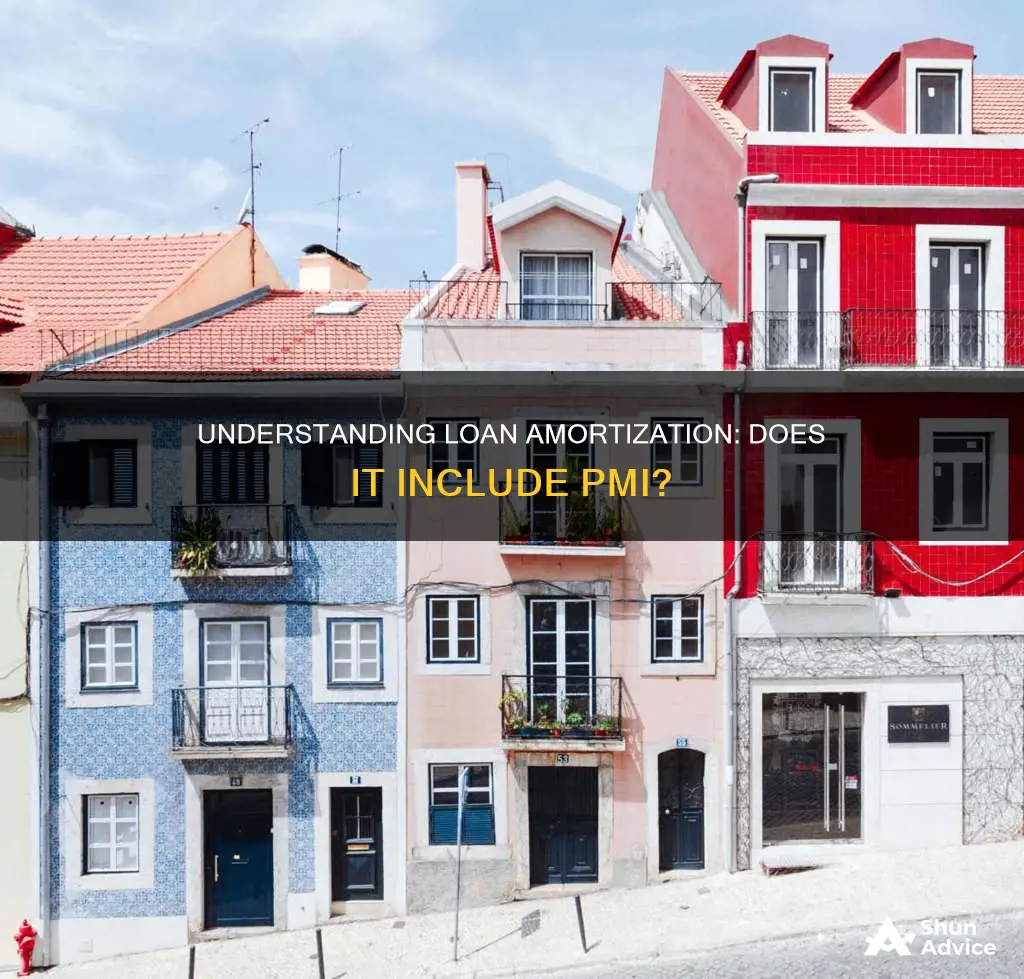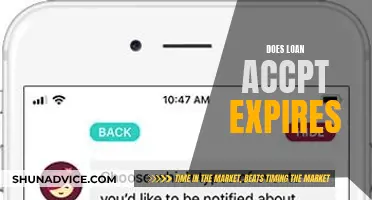
When taking out a loan, it is important to understand the process of loan amortization, which is the repayment of the loan through regular instalments. This can be done through a variety of methods, such as making extra payments or paying larger-than-required amounts each month. One important aspect to consider is Private Mortgage Insurance (PMI), which is a type of insurance that protects the lender in case the borrower stops making payments. PMI is typically required if the borrower takes out a conventional mortgage and makes a down payment of less than 20%. PMI can be included in the monthly payments or paid upfront, and it is important to understand how it affects the amortization schedule of a loan. Online tools such as mortgage calculators can be used to estimate monthly payments, including PMI, and provide an amortization schedule.
| Characteristics | Values |
|---|---|
| What is loan amortization? | The process of paying down a home loan. |
| What is PMI? | Private Mortgage Insurance. |
| Who needs PMI? | Those who take out a conventional mortgage and put down less than 20%. |
| How is PMI paid? | Through a monthly premium that is part of the mortgage payment. |
| Can you avoid PMI? | Yes, by making a 20% down payment or cancelling PMI once you reach 20% equity. |
| How to calculate amortization? | Use a mortgage calculator to estimate monthly payments, including PMI, taxes, insurance, etc. |
| How to speed up loan amortization? | By making extra payments or larger-than-required payments each month. |

Calculating PMI
Private Mortgage Insurance (PMI) is an additional insurance policy that protects the lender if the borrower is unable to pay their mortgage. It is usually required when the borrower puts down less than 20% on a conventional home loan. The cost of PMI varies according to several factors, including the down payment amount, credit score, debt-to-income ratio, and loan-to-value ratio.
Calculating the cost of PMI involves considering these factors and using a PMI calculator. Here is a step-by-step guide to calculating PMI:
- Determine the loan type and term: The first step is to identify the type and term of the loan you are considering. Different types of loans, such as conventional, VA, or FHA loans, have different requirements and PMI considerations. The loan term, such as 15-year or 30-year, will also impact the PMI cost.
- Gather financial information: Collect the necessary financial information, including your credit score, down payment amount, and loan details. Your credit score plays a significant role in determining your PMI rate, with lower credit scores resulting in higher PMI costs. The down payment amount also affects your PMI rate, as a larger down payment can reduce the interest rate and fees associated with the loan.
- Use a PMI calculator: Plug the information gathered in the previous step into a PMI calculator. Reputable websites like NerdWallet, Credit Karma, and HSH offer free PMI calculators. These tools will estimate your monthly PMI cost based on the information provided.
- Review the results: The PMI calculator will provide an estimated PMI rate, monthly PMI cost, and, in some cases, the total cost of PMI over the full term of the loan. It may also include information about when the PMI policy will cancel.
- Compare options: Repeat the calculation for different loan scenarios to compare the PMI costs. For example, you can adjust the down payment amount or loan term to see how it impacts the PMI cost. This will help you make an informed decision about your loan and PMI options.
By following these steps and using the provided resources, you can effectively calculate the PMI cost for your specific situation. Remember that the PMI calculator provides an estimate, and it is always recommended to consult a financial professional for personalized advice.
Lightstream Loans: Prepayment Penalties and You
You may want to see also

Avoiding PMI
Private mortgage insurance (PMI) is a type of insurance that lenders require when homebuyers make a down payment of less than 20% of the home's value. This insurance protects the lender in case the borrower defaults on the loan. While PMI enables buying a home with less than 20% down, it adds an extra monthly fee, increasing your monthly mortgage payment. Therefore, homebuyers may want to consider ways to avoid paying PMI.
One way to avoid PMI is to make a down payment of at least 20% of the home's purchase price. This option provides the additional benefit of a lower mortgage interest rate and immediate ownership of a larger stake in the home. However, it is important to maintain a cushion of savings for furnishing, maintenance, and emergency expenses, instead of emptying your savings account to meet the 20% down payment threshold.
Another option to avoid PMI is to explore alternative loan programs that either waive the PMI requirement or provide down payment assistance. For example, VA loans, backed by the Department of Veterans Affairs, do not require a down payment or mortgage insurance. Similarly, USDA loans, backed by the U.S. Department of Agriculture, are zero-down mortgages for lower- and moderate-income buyers in designated rural and suburban areas. Additionally, loans insured by the Federal Housing Administration (FHA) typically allow down payments as low as 3% and come with a version of mortgage insurance.
A third strategy to avoid PMI is to consider lender-paid mortgage insurance (LPMI), where the lender covers your mortgage insurance, and you pay a higher interest rate in return. However, it is important to note that LPMI cannot be cancelled, even if you pay your mortgage balance down below 80% of the home's value. In contrast, traditional PMI is automatically cancelled when your mortgage balance reaches 78% of the home's value or the halfway mark of the mortgage term.
Finally, homebuyers can avoid PMI by taking out a piggyback mortgage or an 80-10-10 loan, which involves putting 10% down and taking out a 10% home equity line of credit to satisfy the 20% down payment requirement. This option requires a strong credit score and the ability to apply and qualify for two loans. While this strategy helps avoid PMI, the monthly mortgage payment will be higher due to the higher interest rate charged.
Lendmark Title Loans: What You Need to Know
You may want to see also

Amortization schedules
Amortization is the process of paying off a debt or loan over time in predetermined, regular installments. Each repayment for an amortized loan will contain both an interest payment and a payment towards the principal balance. An amortization schedule is a table that outlines each of these monthly payments from the time the borrower starts repaying the loan until the loan matures or is paid off. It shows how much will be paid toward each component of the mortgage payment—principal or interest—at various times throughout the loan term. The total monthly payment usually remains the same, but the amounts of each of these payment components change over time as the loan is repaid and the loan's remaining term declines.
For example, say you take out a $300,000 30-year mortgage with a 6% interest rate. Excluding any additional fees and costs, your monthly payment would be $1,799 for the duration of the loan. However, your first payment would consist of $1,500 paid to interest and the remaining $299 paid to principal. Over time, you'll pay less in interest and more towards the principal with each payment until the loan is paid off.
Borrowers who fall behind on their loan payments could experience negative amortization, where the loan's outstanding balance grows larger instead of smaller. Sticking to the loan repayment schedule will avoid this by paying off each month's principal and interest charges.
Leasing a Vehicle: A Loan or Not?
You may want to see also

Negative amortization
The recast period for negative amortization loans is usually 60 months (5 years), after which the payment is typically recalculated to a fully amortizing schedule. Most loans only allow negative amortization to happen for no more than 5 years. During the negative amortization period, the borrower makes partial payments, which are lower than the amount of interest accrued during the payment term. This can provide payment flexibility for the borrower but can also increase their exposure to interest rate risk.
LendingTree's HELOC Loan Options: What You Need to Know
You may want to see also

PMI costs
Private Mortgage Insurance (PMI) is often a requirement for homebuyers who pay less than 20% of the down payment on a conventional loan. PMI protects the lender in case the buyer is unable to make their mortgage payments. The cost of PMI is usually included in the monthly mortgage payment, which also covers the mortgage principal, interest, and taxes.
PMI calculators are available online and can help estimate the monthly PMI cost. These calculators consider factors such as the interest rate, loan amount, loan term, and down payment. By using a PMI calculator, homebuyers can get a more accurate estimate of their PMI costs and make informed decisions about their mortgage expenses.
It is worth noting that PMI is a temporary cost and can be canceled in the future. Homebuyers can also speed up the amortization schedule by making extra or larger-than-required payments each month, reducing the overall cost of PMI over the life of the loan.
Lending Club: Understanding the Loan Denial Factors
You may want to see also
Frequently asked questions
Loan amortization is the process of paying down your home loan. Your amortization schedule affects your payments, home equity, and payoff date.
PMI stands for Private Mortgage Insurance. It is a type of home loan insurance that you're typically required to pay if you take out a conventional mortgage and put down less than 20%.
You can pay for PMI through a monthly premium that is part of your mortgage payment, or you may pay upfront at closing or a combination of both. The cost of PMI is usually around 0.2% to 2% of the loan amount per year.
Yes, loan amortization can show PMI. There are various online calculators that can help you understand your loan amortization and how much you will be paying in PMI.
In most cases, you can only avoid PMI if you have 20% equity in your home. This means you can either make a 20% down payment or cancel your PMI once you reach 20% equity.







